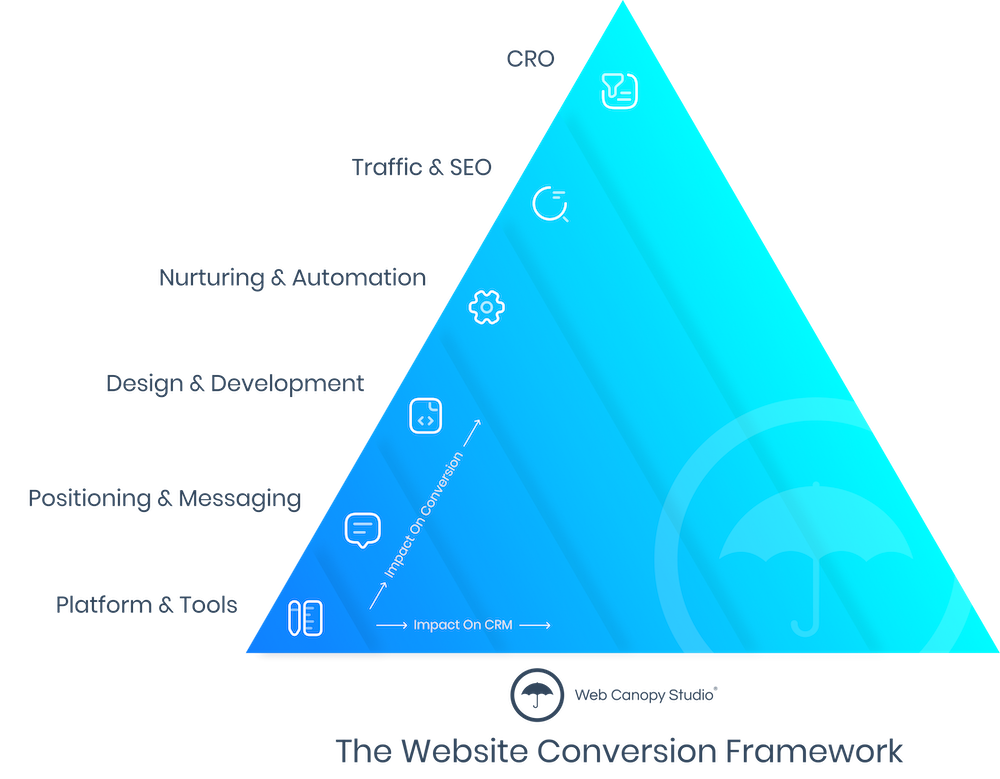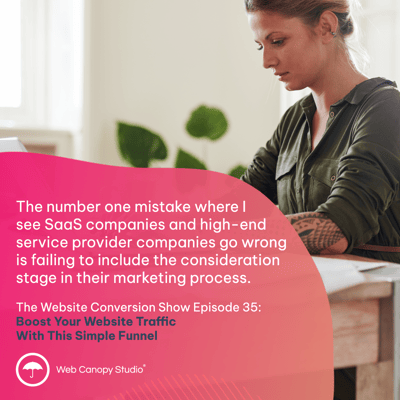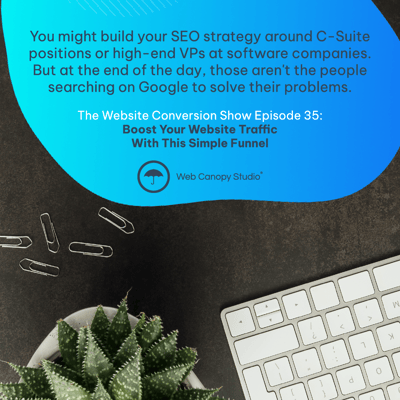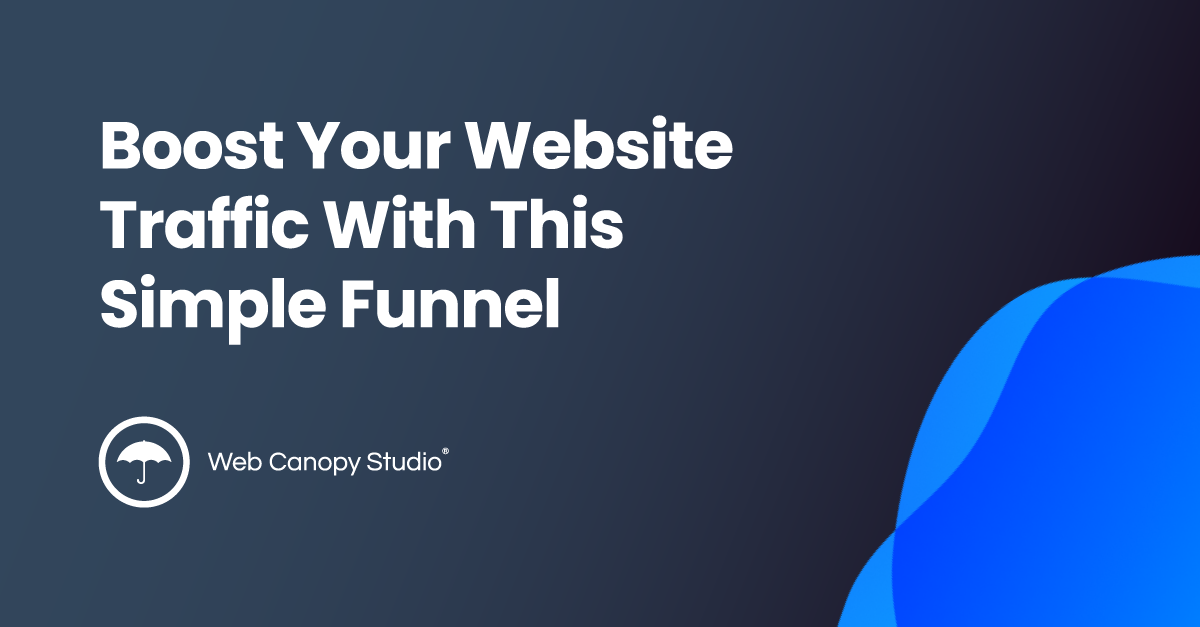If you’re like us, you are always looking for more ways to boost traffic to your website.
Everyone loves to talk about SEO, which is an essential tool for a great website, but what other ways can you generate quality traffic?
Let's walk through a simple funnel you can apply to sell more of whatever your business does best. Here’s a breakdown of what we’ll be covering:
- Why paid ads in the B2B world are done entirely wrong (and how to actually do them the right way).
- The one crucial step every business misses while implementing their marketing funnels
- The four-step process of doing paid ads the RIGHT WAY will result in increasing your booked calls/demos every month.
- The exact numbers and targets you can swipe for your conversion rates and lead generation.
Before we build an effective ad funnel, we need to understand how this fits into our Website Conversion Framework.

Like all pyramids, you need to start with a solid foundation; check out some of our latest blogs to see how we did that. Today we will be focusing on the traffic and SEO level, but rather than go down the rabbit hole of SEO, we are zeroing in on ad funnel strategies.
When it comes to companies that specialize in software or B2B, specialized products that have a lot of consideration, we need qualified leads. SEO is most effective for a consumer looking to solve a specific problem, not for products that will be considered and adopted by entire teams.
Enter the ad funnel strategy. An often misused tool, but when implemented properly it can be the most effective strategy to generate qualified leads for your business.
What everyone else gets wrong
Many companies spend thousands and thousands of dollars on “branding campaigns” buying up Google Keywords, Facebook Ads, and LinkedIn Ads, all just to send people to their home page or about page.
This can create brand awareness, but it doesn’t generate leads.
Poor strategy leads to underperforming ad campaigns and wasted money on clicks that don’t convert.
This education-focused approach isn’t always bad, but it doesn’t lead to client acquisition.
Now, let’s go through the steps of the funnel together and see what kind of conversion you can get from a $5,000 monthly ad spend. For this example, we’ll say we are using Facebook ads because it’s the most general but this can obviously apply to any paid web advertising.
Click
Many of you already have a landing page on your website where you are giving away something for free. A checklist, a worksheet, some sort of lead generator that, when targeted at the right audience, will drive traffic at scale. Spend your ad budget on those types of contacts. Some are already doing this, most aren’t.
Once we create a tailored ad with a hook, story, and offer we should see a conversion rate that works out to roughly $5 per click. Some will be less, some more, but that’s a good baseline to start.
At this rate, our $5,000 budget would give us 1,000 clicks. One thousand people have now seen your landing page.
Awareness
Your landing page needs to be an awareness stage offer. A lead magnet. A checklist or assessment for others to use.
As mentioned in step one, most of you will already have this. If you don’t, make one. It should be something of value that solves an immediate problem.
On this landing page, we are looking for a 10% conversion rate. This may seem high to some of you who ran branding campaigns that converted at 2-3%.
However, with landing page offers like this, our average conversion rate is 30% with top performers closer to 50% so 10% is very achievable.
We have now converted our $5,000 to 1,000 clicks to 100 leads. Don’t stop at leads.

Consideration
This is the step most companies skip. Don’t be like most companies.
It’s very difficult to take someone from a complete stranger to a customer. We need to walk them through a natural progression and engage them with our company.
We can’t send one email newsletter and expect to book new clients at scale, we have to put ourselves in the shoes of the people we are talking to.
At this stage, we need to have a campaign running. If you use Hubspot you can track that campaign very well. There are many ways to nurture this relationship but you’ll have to decide what works best for your company and the situation you’re currently in.
You could send out some personalized emails, message on LinkedIn, or assign a salesperson to the prospect if it’s not too early to do so.
The goal of this consideration stage should be to eventually get them to watch a consideration video. This could be a webinar, a masterclass, or even a live event. Masterclass has worked really well for our agency but use what suits your company best. The video is the end goal of this stage.
The goal is to get 40% of prospects in the consideration stage to watch your video.
Our $5,000 has now turned into 1,000 clicks, 100 leads, and 40 engaged clicks.
Decision
40 people are now engaged enough to make it through the consideration stage. Great, now what? We continue to nurture the relationship and move them towards making a decision.
They’ve watched your video, they’ve read your case studies and reviews, and now they need to book a call with you.
We actually just had an entire blog about booking demos, so check out more details on that there.
To successfully move through the decision stage, our prospect needs to book a follow up. Our goal is that 30% of people who enter the decision stage will book a call.
So now, $5,000 has become 1,000 clicks, which generated 100 leads, 40 engaged clicks, and 12 booked calls. All that’s left to do is close.

Close
We all know closing is easier said than done, but a good benchmark here is 30% depending on your business and your sales team. Some may close more than 80% of deals that reach this stage, and that’s great!
We’ll be conservative and assume you can close 20% of deals that make it to the last step of your funnel.
Boom. You just closed 2-3 deals.
Let’s assume that you are licensing your software or service for $5,000/month, so $60,000 in annual revenue or each account. You just generated $120,000 - $180,000 in annual recurring revenue from a single $5,000 ad campaign.
Now imagine running this campaign for 12 months and tweaking and optimizing your funnel along the way.
Once you establish your baseline, in this case $5,000 = 2 closed deals. You can then just adjust your spending until you have your desired level of demand.
Recap
Let’s quickly break down the ad funnel one more time.
First, we have the targeted ad. A compelling hook story offer that gets people to engage.
Second, the awareness stage. Here we send them to a compelling lead magnet (not a homepage) where we get them to convert.
Third, nurturing/consideration stage. We get them to engage with something that's helpful and will help solve more problems for them, but also help them build a little bit of more trust with us.
Fourth, the decision stage. Get them to book a demo or strategy session.
Finally, close.
That’s how we build an ad funnel and boost traffic to your website.



